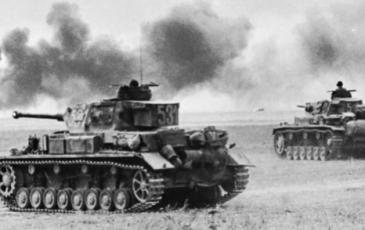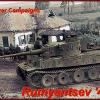#43_0803_03: Operation Rumyantsev, The Fourth Battle of Kharkov (1st Tank Army and 5th Guards Tank Army Weakened) - PzC 26 Rumyantsev '43


#43_0803_03: Operation Rumyantsev, The Fourth Battle of Kharkov (1st Tank Army and 5th Guards Tank Army Weakened)
By Daniel Asensio 0 - 0 - 0
0 - 0 - 0

| Rating: | 0 (0) |
| Games Played: | 0 |
| SM: | 9 |
| Turns: | 218 |
| Type: | Stock |
| First Side: | Soviet |
| Second Side: | Germany |
Date: August 3rd, 1943 - Size: Campaign - Location: Belgorod-Kharkov area
Designer Notes: This is the historical campaign but with the 1st Tank Army and 5th Guards Tank Army remaining weakened after Operation Zitadelle, as the Germans had expected.
Scenario Briefing: The Belgorod-Kharkov Offensive Operation (also known as Operation Polkovodets Rumyantsev) was one of the counterattacks planned by the Soviets after Operation Zitadelle, the first of which, Operation Kutuzov, was launched on July 12th. The second, Operation Rumyantsev, was launched on August 3rd and the third, Operation Suvorov, started on August 7th in the area of Smolensk. For Operation Rumyantsev, the Soviet high command concentrated forces in the former theater of operations south of Zitadelle, including the Voronezh Front, with seven armies, two of which being tank armies, the Steppe Front with three armies and the Southwestern Front which would cooperate with two more armies. The Voronezh Front had been rebuilt after Zitadelle, with the armored units practically at their theoretical strength. The Germans, on the other hand, held only a tiny fraction of the units in the area that took part during Zitadelle. Their best units were sent to the Orel salient (Grossdeutschland), to the Mius area (SS Divisions), and to Italy in response to the Allied landing. The only advantage retained by the Germans was that they were familiar with the theater of operations and had good defensive positions. They also retained several panzer divisions in reserve, although Manstein did not believe that the Soviets would launch an attack so soon due to their allegedly high losses south of the Kursk salient. The attack began on the morning of August 3rd after an intense artillery barrage. On the right wing of the German front, Soviet infantry units were launched en masse against the various, in-depth German defensive positions. They broke through with heavy losses, after which the 1st Tank Army and 5th Guards Tank Army plunged through. The German high command had no choice but to mobilize its armored reserves to try to stop the Soviet tanks. Despite this commitment, the Germans were overrun at various points of the front, creating a pocket in the area of Borisovka-Tromarovka while defending the approaches to the city of Belgorod. The German left wing held out much better but eventually retreated westward. Despite German efforts, large holes were opened in the German front which the Soviets took advantage of to launch their armored units to the south, leaving infantry behind to reduce pockets of German resistance. Soviet tanks liberated cities as they rapidly advanced south. Meanwhile, the Germans began a difficult retreat towards the city of Kharkov, which Hitler gave the order to defend. After the reduction of the Tomarovka-Borisovka pocket and the liberation of Belgorod, Soviet infantry units began their advance southwards in the wake of Red Army tanks. To close the large gap between PzAOK.4 and Armee-Abteilung Kempf, and hopefully regain the initiative, German command devised a counterattack in the Bogodukhov area, moving in various units from the Orel salient and the Mius area. The counterattack would be staged by the III.PzK from the south and the XXIV.Pzk from the north while defending Kharkov hand in hand. Although the Bogodukhov counterattack largely failed in its tactical and strategic elements, it still allowed the Germans to regain part of the initiative and make an orderly retreat towards the Dniepr. Kharkov’s defense also helped in this objective, as it kept several Soviet armies occupied in a costly battle for the city before it fell.
Recommended Rules: (Default)
Alternative Assault Resolution, Artillery Set Up, Recon Spotting, Virtual Supply Trucks, Low Visibility Air Effects, Quality Fatigue Modifier, Counterbattery Fire, Night Fatigue, Programmed Weather, Limited Air Recon.
Designer Notes: This is the historical campaign but with the 1st Tank Army and 5th Guards Tank Army remaining weakened after Operation Zitadelle, as the Germans had expected.
Scenario Briefing: The Belgorod-Kharkov Offensive Operation (also known as Operation Polkovodets Rumyantsev) was one of the counterattacks planned by the Soviets after Operation Zitadelle, the first of which, Operation Kutuzov, was launched on July 12th. The second, Operation Rumyantsev, was launched on August 3rd and the third, Operation Suvorov, started on August 7th in the area of Smolensk. For Operation Rumyantsev, the Soviet high command concentrated forces in the former theater of operations south of Zitadelle, including the Voronezh Front, with seven armies, two of which being tank armies, the Steppe Front with three armies and the Southwestern Front which would cooperate with two more armies. The Voronezh Front had been rebuilt after Zitadelle, with the armored units practically at their theoretical strength. The Germans, on the other hand, held only a tiny fraction of the units in the area that took part during Zitadelle. Their best units were sent to the Orel salient (Grossdeutschland), to the Mius area (SS Divisions), and to Italy in response to the Allied landing. The only advantage retained by the Germans was that they were familiar with the theater of operations and had good defensive positions. They also retained several panzer divisions in reserve, although Manstein did not believe that the Soviets would launch an attack so soon due to their allegedly high losses south of the Kursk salient. The attack began on the morning of August 3rd after an intense artillery barrage. On the right wing of the German front, Soviet infantry units were launched en masse against the various, in-depth German defensive positions. They broke through with heavy losses, after which the 1st Tank Army and 5th Guards Tank Army plunged through. The German high command had no choice but to mobilize its armored reserves to try to stop the Soviet tanks. Despite this commitment, the Germans were overrun at various points of the front, creating a pocket in the area of Borisovka-Tromarovka while defending the approaches to the city of Belgorod. The German left wing held out much better but eventually retreated westward. Despite German efforts, large holes were opened in the German front which the Soviets took advantage of to launch their armored units to the south, leaving infantry behind to reduce pockets of German resistance. Soviet tanks liberated cities as they rapidly advanced south. Meanwhile, the Germans began a difficult retreat towards the city of Kharkov, which Hitler gave the order to defend. After the reduction of the Tomarovka-Borisovka pocket and the liberation of Belgorod, Soviet infantry units began their advance southwards in the wake of Red Army tanks. To close the large gap between PzAOK.4 and Armee-Abteilung Kempf, and hopefully regain the initiative, German command devised a counterattack in the Bogodukhov area, moving in various units from the Orel salient and the Mius area. The counterattack would be staged by the III.PzK from the south and the XXIV.Pzk from the north while defending Kharkov hand in hand. Although the Bogodukhov counterattack largely failed in its tactical and strategic elements, it still allowed the Germans to regain part of the initiative and make an orderly retreat towards the Dniepr. Kharkov’s defense also helped in this objective, as it kept several Soviet armies occupied in a costly battle for the city before it fell.
Recommended Rules: (Default)
Alternative Assault Resolution, Artillery Set Up, Recon Spotting, Virtual Supply Trucks, Low Visibility Air Effects, Quality Fatigue Modifier, Counterbattery Fire, Night Fatigue, Programmed Weather, Limited Air Recon.




















